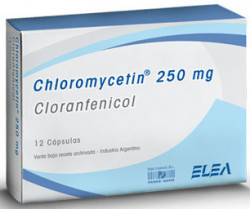Chloromycetin (chloramphenicol) Coupons, Discounts & Cost
Chloromycetin (chloramphenicol) is an antibiotic with a wide spectrum of activity. One way to save money on the Chloromycetin (chloramphenicol) retail cost regardless of income and insurance status is to use Chloromycetin (chloramphenicol) coupons or discount cards from RXCoupons. Use this Chloromycetin (chloramphenicol) coupon at this online pharmacy and receive up to 75% off the sale price.
What should I know about Chloromycetin (chloramphenicol)?
Chloromycetin (chloramphenicol) is an antibiotic with a wide spectrum of activity. Chloramphenicol is effective against gram-negative and gram-positive microorganisms, including some viruses of the psittacosis group, but has no effect on influenza viruses and other viruses. It is intended for the treatment of various infectious diseases. The drug has a bacteriostatic action.
Chloramphenicol is used to treat infectious and inflammatory diseases. The drug is widely used in pediatric ophthalmology.
According to the instructions, chloramphenicol is well and rapidly absorbed. It penetrates into the cerebrospinal fluid and breast milk. It is used in a daily dose of 20-30 mg (50 mg) per 1 kg of body weight per day, divided into 4 doses (every 6 hours).
Chloramphenicol has the same side effects as other antibiotics. It can cause aplastic anemia and agranulocytosis.
Chloromycetin (chloramphenicol) main indications
Chloromycetin (chloramphenicol) is used to treat generalized forms of salmonellosis, typhoid and paratyphoid, tularemia, rickettsial diseases, brucellosis, meningitis.
According to the instructions, chloramphenicol may be used for treatment of other infectious diseases (caused by microorganisms susceptible to the active substance of the drug). It is used for burns, bedsores, venous ulcers, acne, pyoderma, eczema. The drug is used in chronic inflammatory processes in ophthalmology and gynecology. In ophthalmology, chloramphenicol is used to treat conjunctivitis, blepharitis, keratitis.
Chloromycetin (chloramphenicol) main contraindications
Chloromycetin (chloramphenicol) is contraindicated in the following cases: individual intolerance, some skin diseases (fungal infections, psoriasis, eczema), hematopoietic function inhibition.
According to the instructions, chloramphenicol is contraindicated in pregnant women and nursing mothers. Do not use this drug for the treatment of newborn babies, because it may cause nausea, bloating, hypothermia, cyanosis, respiratory failure and symptoms of cardiovascular disease.
Chloromycetin (chloramphenicol) dosing regimen
The drug is usually taken before meals. Adults: 0.25-0.5 g every six hours. Patients may take 1 g 4 times a day for the treatment of very severe infections. In this case, you need to carefully monitor renal and liver function.
Chloramphenicol dosage for children is calculated on the basis of the child's age and his body weight. Duration of therapy is 7-10 days. In case of good tolerability, the course can be extended up to 14 days.
Chloromycetin in ophthalmology: use two drops of chloramphenicol 3 to 5 times a day. Duration of therapy is 1-2 weeks.
Chloromycetin (chloramphenicol) side effects
The following disorders may develop during Chloromycetin (chloramphenicol) therapy: reticulocytopenia, leukopenia, thrombocytopenia, anemia, allergic reactions, reduced visual acuity and impaired hearing, confusion, psychomotor agitation, visual and auditory hallucinations, dyspepsia. Central and peripheral nervous system: headache, confusion, visual and auditory hallucinations, psychomotor disturbances. Hematopoietic system: leukopenia, rarely - aplastic anemia. Digestive system: nausea, vomiting, diarrhea. Dermatological reactions: rash, urticaria, allergic reactions. Discontinuation of the drug is recommended in case of severe reactions.
Chloromycetin (chloramphenicol) special instructions
Chloromycetin (chloramphenicol) should not be used for the treatment of acute respiratory infections (sore throat) and any mild infectious processes. Do not use the drug as a prophylactic measure. Chloramphenicol should be used with great caution in patients after radiation therapy or treatment with cytotoxic drugs.
Patients should not drink alcoholic beverages during treatment with chloramphenicol, as this may lead to nausea, vomiting, flushing of the skin, reflex cough, tachycardia, and convulsions.
Patients should regularly monitor blood counts during treatment with chloramphenicol.
Do not use Chloromycetin simultaneously with cytostatic agents, indirect anticoagulants and barbiturates.

